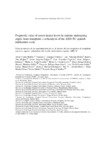Mostrar o rexistro simple do ítem
Prognostic value of serum lactate levels in patients undergoing urgent heart transplant: a subanalysis of the ASIS-TC spanish multicenter study
| dc.contributor.author | Couto-Mallón, David | |
| dc.contributor.author | González-Vílchez, Francisco | |
| dc.contributor.author | Almenar-Bonet, Luis | |
| dc.contributor.author | Díaz-Molina, Beatriz | |
| dc.contributor.author | Segovia-Cubero, Javier | |
| dc.contributor.author | González-Costello, José | |
| dc.contributor.author | Delgado-Jiménez, Juan F. | |
| dc.contributor.author | Castel-Lavilla, María A. | |
| dc.contributor.author | Crespo-Leiro, María Generosa | |
| dc.contributor.author | Rangel-Sousa, Diego | |
| dc.contributor.author | Martínez-Sellés, Manuel | |
| dc.contributor.author | Rábago, Gregorio | |
| dc.contributor.author | De-la-Fuente Galán, Luis | |
| dc.contributor.author | Blasco-Peiró, Teresa | |
| dc.contributor.author | Hervás-Sotomayor, Daniela | |
| dc.contributor.author | Garrido-Bravo, Iris P. | |
| dc.contributor.author | Mirabet, Sonia | |
| dc.contributor.author | Muñiz, Javier | |
| dc.contributor.author | Barge-Caballero, Eduardo | |
| dc.date.accessioned | 2019-03-04T12:57:45Z | |
| dc.date.issued | 2018-05-30 | |
| dc.identifier.citation | Couto-Mallón D, González-Vílchez F, Almenar-Bonet L, et al. Prognostic value of serum lactate levels in patients undergoing urgent heart transplant: a subanalysis of the ASIS-TC spanish multicenter study. Rev Esp Cardiol (Engl ed). 2019; 72(3): 208-214 | es_ES |
| dc.identifier.issn | 1885-5857 | |
| dc.identifier.uri | http://hdl.handle.net/2183/22073 | |
| dc.description.abstract | [Abstract] Introduction and objectives. To study the prognostic value of serum lactate in patients under temporary preoperative mechanical circulatory support who underwent urgent heart transplant. Methods. We conducted a subanalysis of a Spanish multicenter registry recording data on patients under temporary mechanical circulatory support listed for highly urgent heart transplant from 2010 to 2015. Participants selected for the present study were those who received a transplant and who had known preoperative serum lactate levels. The main study outcome was 1-year survival after transplant. Results. A total of 177 heart transplant recipients were studied; preoperatively, 90 were supported on venoarterial extracorporeal membrane oxygenation, 51 on temporary left ventricular assist devices, and 36 on temporary biventricular assist devices. Preoperative hyperlactatemia (≥ 2 mmol/L) was present in 44 (25%) patients. On multivariable analysis, pretransplant serum lactate was identified as an independent predictor of 1-year posttransplant survival (adjusted HR per 0.1 mmol/L, 1.02; 95%CI, 1.01-1.03; P = .007). One-year posttransplant survival was 53.1% (95%CI, 45.3-60.9) in patients with preoperative hyperlactatemia and 75.6% (95%CI, 71.8-79.4) in those without preoperative hyperlactatemia (adjusted HR, 1.94; 95%CI, 1.04-3.63; P = .039). Preoperative hyperlactatemia correlated with adverse outcomes in patients supported with extracorporeal membrane oxygenation, but not in patients supported on ventricular assist devices. Conclusions. Preoperative serum lactate is a strong independent predictor of worse outcomes in patients undergoing urgent heart transplant on short-term mechanical circulatory support. | es_ES |
| dc.description.abstract | [Resumen] Introducción y objetivos. Analizar el impacto del lactato sérico en receptores de trasplante cardiaco urgente en asistencia circulatoria mecánica de corta duración preoperatoria. Métodos. Se realizó un subanálisis de un registro multicéntrico español basado en pacientes incluidos en «urgencia grado 0» para trasplante cardiaco con asistencia circulatoria mecánica preoperatoria de corta duración entre 2010 y 2015. Se seleccionó a los receptores de trasplante con cifras preoperatorias de lactato conocidas. El desenlace principal fue la supervivencia 1 año tras el trasplante. Resultados. Se estudió a 177 receptores de trasplante cardiaco urgente, de los que 90 necesitaron asistencia preoperatoria con oxigenador extracorpóreo de membrana venoarterial, 51 con asistencia ventricular izquierda y 36 con asistencia biventricular. De ellos, 44 (25%) presentaban hiperlactatemia antes del trasplante (≥ 2 mmol/l). En el análisis multivariable, la cifra de lactato sérico resultó predictora independiente de mortalidad tras el trasplante (cada 0,1 mmol/l, HR ajustada = 1,02; IC95%, 1,01-1,03; p = 0,007). La supervivencia estimada al año del trasplante cardiaco fue del 53,1% (IC95%, 45,3-60,9) en los pacientes con hiperlactactemia preoperatoria y el 75,6% (IC95%, 71,8-79,4) en los pacientes sin hiperlactatemia (HR ajustada = 1,94; IC95%, 1,04-3,63; p = 0,039). El impacto pronóstico de la hiperlactatemia fue significativo en los pacientes asistidos con oxigenador extracorpóreo de membrana venoarterial, pero no en aquellos con dispositivos de asistencia ventricular. Conclusiones. Los valores preoperatorios de ácido láctico son un potente factor pronóstico independiente en receptores de trasplante cardiaco urgente. | es_ES |
| dc.language.iso | eng | es_ES |
| dc.publisher | Elsevier | es_ES |
| dc.relation.uri | https://doi.org/10.1016/j.rec.2018.02.021 | es_ES |
| dc.rights | Atribución-NoComercial-SinDerivadas 3.0 España | es_ES |
| dc.rights.uri | http://creativecommons.org/licenses/by-nc-nd/3.0/es/ | * |
| dc.subject | Lactate | es_ES |
| dc.subject | Heart transplant | es_ES |
| dc.subject | Mechanical circulatory support | es_ES |
| dc.subject | Lactato | es_ES |
| dc.subject | Trasplante cardiaco | es_ES |
| dc.subject | Asistencia circulatoria mecánica | es_ES |
| dc.title | Prognostic value of serum lactate levels in patients undergoing urgent heart transplant: a subanalysis of the ASIS-TC spanish multicenter study | es_ES |
| dc.title.alternative | Valor pronóstico de la concentración sérica de lactato de los receptores de trasplante cardiaco urgente: subanálisis del estudio multicéntrico español ASIS-TC | es_ES |
| dc.type | info:eu-repo/semantics/article | es_ES |
| dc.rights.access | info:eu-repo/semantics/openAccess | es_ES |
| dc.date.embargoEndDate | 2019-05-30 | es_ES |
| dc.date.embargoLift | 2019-05-30 | |
| UDC.journalTitle | Revista Española de Cardiología (English edition) | es_ES |
| UDC.volume | 72 | es_ES |
| UDC.issue | 3 | es_ES |
| UDC.startPage | 208 | es_ES |
| UDC.endPage | 214 | es_ES |
Ficheiros no ítem
Este ítem aparece na(s) seguinte(s) colección(s)
-
INIBIC-ICATC - Artigos [177]






